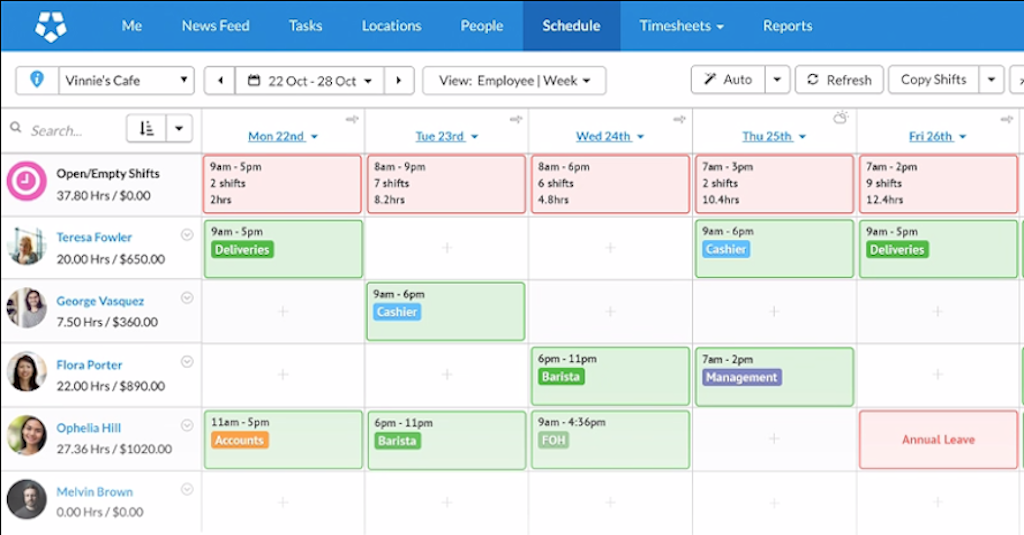
This is a guest post by Derek Jones from Deputy, a global workforce management platform for employee scheduling, timesheets, and communication. With a focus on Emerging Retail, Derek helps business owners and workforce leaders simplify employment law compliance, keep labor costs in line, and build award-winning workplaces. Derek has over 16 years’ experience in delivering data-driven sales and marketing strategies to SaaS companies like MarketSource and Griswold Home Care.
One of the many factors that can help guarantee the success and growth of a business today is employee performance.
Most organizations know this. Therefore, they want employees that are as efficient as possible. However, that is easier said than done, especially in industries where activities often run at odd hours or even 24/7.
For such industries (like healthcare, hospitality, and retail in particular), one of the most important things they’ll need to manage is shift work scheduling.
Through optimization, the task of scheduling shift work will have a structure to minimizes employee burnout and improve overall performance.
Employees that work in an enabling environment have a higher chance to properly complete all important tasks – on schedule.
In view of that, in this Process Street article, we will:
- Discuss some of the issues and challenges that surround shift work.
- Take a look at up-to-date research regarding employee performance.
- Summarize 3 shift-work goals you can incorporate to optimize your shift work schedule.
- Give top tips on shift work scheduling to maximize employee productivity and retention.
Click on the relevant subheaders below to jump to that section, alternatively scroll down to read all, and find out how you can optimize your shift work schedules today!
- Schedule optimization: Using BPM in shift work
- Shift work scheduling: The top 3 shift work issues
- How do common shift work issues impact employee performance?
- Schedule optimization: 3 goals to optimize your shift schedule
- Shift work scheduling: Scheduling tips and tricks for shift work
Schedule optimization: Using BPM in shift work
Scheduling is the process of arranging and controlling workloads. In this instance, we are talking about arranging and controlling workloads between employees across a 24 hour-period time frame via shift work scheduling. Schedule optimization looks at making the best and most effective use of your employees and their time. To meet their professional needs whilst getting the job done.
Whilst the connection might not be obvious, shift work and business process management have a strong association. Shift schedules define who is doing the work and when that work is happening. BPM supplements this, by managing how that work is done and how it can be optimized.
Think about it this way.
What makes shift work scheduling hard?
It might be a lack of skilled workforce on the market, the prevalence of overtime work confusing things, poor productivity levels, high peak times, onboarding processes that require a mentor, and so on.
What do most of these issues have in common?
They can be partially remedied by defining strong business management processes. In essence, well-optimized business procedures save time and leave you with more breathing room when designing shift schedules. This is where Process Street, as a BPM tool, comes in.
Process Street is superpowered checklists. You can create a checklist for any procedure, to enhance efficiency, effectiveness, and productivity. This includes creating, implementing, and maintaining shift work schedules.
For more information on Process Street, watch the below webinar: An Introduction to Process Street.
Before delving deeper into how Process Street can help you optimize shift work schedules, it is important to understand the issues surrounding shift work and the impact these issues have on employee performance.
Shift work scheduling: The top 3 shift work issues
Shift work is unavoidable in many industries that are required to provide services well beyond regular hours. Some of the most common sectors for this practice include services such as protection (police and firefighters), healthcare, food, hospitality, transportation, manufacturing, and similar.
If you operate (or intend to operate) a business that will be available for longer hours than usual, then you’ll need to understand the intricacies of shift work.
Regardless of your industry, there are certain issues unique to shift work as a whole. These issues can affect overall organizational performance and cause stress for everyone, whether you’re a manager or an employee.
It is important employee stress is appropriately managed, supporting employees as much as possible. To assist you with this, use our Critical Incident Stress Management Checklist, provided below.
Click here to access our Critical Incident Stress Management Checklist
We will point out 3 issues of top-most concern when it comes to shift-work, namely:
- Shift disruptions
- Overtime
- Circadian rhythm disruptions
It is important to be aware of these issues, and the impact they have on employee performance, to optimize your shift schedules.
Shift work issue #1: Shift disruptions
Even the most well-planned shifts will experience disruptions and interval adjustments due to life issues like illnesses, traffic, irresponsible workers, etc.
It is important to be aware of this risk and to remain flexible to adjust to unexpected changes.
A good model to use is the PDCA cycle. This cycle runs by continuously assessing risk, pain points, and areas for improvement. Running this cycle on your shift schedule will assist in schedule optimization.
Click here to access the PDCA Cycle Change Management Process Checklist
Shift work issue #2: Overtime
Let’s imagine a situation where a nonexempt employee works a few hours longer than the usual 40-hour workweek. The job gets done without having to hire more staff, and the employee also gets premium compensation. Everyone is happy until overtime becomes excessive and gradually begins to affect performance.
Several studies indicate that productivity doesn’t necessarily increase with more hours worked. That is, productivity is not linear.
If you want further advice on how to boost workplace productivity, read: How to Boost Workplace Productivity: 5 Tech Examples
While some workers are more resilient than others, constant overtime work is most likely to lead to decreased overall productivity. It’s more a question of when a drop in overall productivity will happen, it could be after say 1 week, 1 month, or 6 months.
Productivity aside, research from Cornell University suggests that more hours at work can affect family wellbeing especially for workers who exceed 50 hours a week.
There are also several prohibitions under the Fair Labor Standards Act (FLSA) that supersede in-house arrangements that you may make with your staff. You should be aware of these restrictions.
Shift work issue #3: Circadian rhythm disruptions
Companies will use different types of work shifts depending on the nature of their operations. But generally, the common work shifts are morning, mid-day, evening, and overnight. Although we have previously established that shift work is unavoidable in certain industries, it can affect individuals negatively, especially staff who are regularly assigned to the night shift.
According to the American Physiological Association, some of the hazards of working at night include restlessness, sleeping on the job, fatigue, decreased attention, and disruption of the body’s metabolic process.
Added to that, The National Sleep Foundation states that:
“long-term night shift work is associated with an increased risk of certain cancers, as well as metabolic problems, heart disease, ulcers, gastrointestinal problems, and obesity.” – The National Sleep Foundation, Living & Coping With Shift Work Disorder
Night shift workers may also be at greater risk of work-related accidents due to a drop in alertness and slower reaction times at night. The science behind this is that working a regular or rotational night shift interferes with the body’s natural diurnal and circadian rhythms – humans have evolved to work during the day and rest at night.
It is therefore prudent to adopt shift systems at the workplace that minimize long-lasting disruption to these biological rhythms and work with your employees to manage night shifts.
How do common shift work issues impact employee performance?

With the 3 negative effects of shift work highlighted above, we will evaluate how each could impact employee performance. To do this, we will focus on 3 industries, namely, healthcare, hospitality, and retail.
Shift work and employee performance in Healthcare
It is the norm that healthcare establishments need to provide care for their patients around the clock. Because of that, health care is the second-highest sector for the number of workers reporting short sleep duration (six hours or less per day). This industry is also known for highly disruptive work shifts.
One of the most frustrating challenges that workers in healthcare face are on-call shifts. This is a practice where an employee’s work schedule is intentionally unpredictable. Therefore, doctors, nurses, and other medical personnel often work on-call and are expected to be available to resume back to their posts at any time of day or night, usually with short notice.
Scientific American observed that more than half (about 52%) of those working overnight in Healthcare reported fewer than six hours of sleep. Fatigue among medical personnel has also been shown to increase both errors and injuries in the following ways:
- Exhausted workers in the medical field can endanger other members of the public while commuting home from a night shift.
- Sleep-deprived medical trainees were three times more likely to accidentally stick themselves with a needle or other sharp objects according to The National Center for Biotechnology Information (NCBI).
- Another report suggests that errors resulting from extended work hours and shifts may account for a proportion of the 48,000 to 98,000 patient deaths that occur annually.
These are serious issues, especially when we consider scenarios like in the emergency room where medical staff are required to make split-second, life-or-death decisions during the night shift.
Shift work and employee performance in Hospitality
Hospitality is a broad category that includes businesses in food and drink services, lodging, tourism, transportation (cruise and airline), hotels, etc.
A study by NCBI quoted evidence of a significant association between fatigue and emotional disharmony in both male and female hotel staff. The same source mentioned figures from the Ministry of Labor Statistics, indicating that occupational disasters in the food services and lodging industry have increased over the last five years.
Although this study solely took case studies from hotels located in Seoul, it’s not farfetched to see that they could apply to American hotels as well. For instance, according to the Academic Journal of Industrial Medicine, hotel employees have higher rates of occupational injury and sustain more severe injuries than most other service workers.
The facts are undeniable and lead us to ask: Could these high levels of injuries be the result of reduced attentiveness and alertness from fatigue?
Shift work and employee performance in Retail
Similar to the hospitality industry, retail businesses experience some of their busiest work during holidays, weekends, and late in the evenings when most shoppers are on their way back home from work. The implication of this is a need for late shift staff. Again, shift-work issues creep into the retail industry – issues as already mentioned above.
The National Institute for Occupational Safety and Health reports a connection between nonstandard, irregular, and extended shifts with elevated stress and health issues in retail workers.
Schedule optimization: 3 goals to optimize your shift schedule

In view of all we have discussed above, it’s obvious that your ability to manage and optimize shifts among your staff can make a difference and significantly impact their performance.
On top of the 3 common issues with shift work discussed above, be mindful of the impact of other factors such as shift length, rotation, breaks, and the unique mental and physical stress associated with the job and on employee performance.
That being said, below are 3 major goals to aspire to for shift schedule optimization.
Optimizing shift schedules, goal #1: Maximizing workplace efficiency
Optimizing shift schedules will help to minimize employee burnout, maximize productivity, and reduce staff turnover.
Remember that many workers may not complain about unfavorable working conditions. Instead, they harbor resentment and leave the organization when a better offer comes along. Also, generally unhappy staff are unlikely to put in their best.
As mentioned before, several studies show that although production may increase initially with working hours, average hourly productivity begins to fall as time passes.
Keep your employees engaged and aspire to meet their professional needs.
Optimizing shift schedules, goal #2: Meeting legal obligations
There are regulatory guidelines for workers’ shifts that cover many issues concerning shift work. For instance, several states including California (San Francisco), New York, Pennsylvania, Oregon, Arizona, etc, require that employers give their staff a minimum notice period before making changes to their shifts. There are also guidelines for defining overtime and other issues.
Optimizing shift schedules, goal #3: Improving employee engagement
A well-optimized shift schedule, adjusted to accommodate employee needs, at least to a reasonable extent, can reduce the chances of absenteeism and staff turnover. When employees do not have to continually choose between work and personal obligations, it helps to reduce the chances of absenteeism and the feelings of burnout.
Shift work scheduling: Scheduling tips and tricks for shift work
Regardless of your industry, there are several common challenges that managers often face with regards to optimizing shift schedules and managing their workforce in general. Below, we’ll run through a few tips that can help you avoid many scheduling headaches.
Shift schedulinig tip #1: Create structure and orderliness (focus on the process)
Start by creating a fair and functional schedule that doesn’t violate any regulations. It’s vital that you have operating procedures, checklists, and timetables that spell out how your operations run. Ideally, new staff should have access to this information from day one of the onboarding stage.
This should help to reduce arguments and distractions about work shifts later on.
Create structure and orderliness with Process Street as your BPM software.
Our checklists have the following features, creating dynamic checklist machines:
- Stop tasks to ensure task order.
- Dynamic due dates, so no deadline is missed.
- Conditional logic, creating a dynamic template that caters to your needs.
- Role assignments, to ease task delegation within your team.
- Approvals, allowing decision-makers to give the go-ahead (or rejection) on important items. Also, the necessary comments can be provided.
For more information on how to create a checklist template in Process Street, watch the below video: Basics of Creating and Editing Checklists.
Click here to sign-up to Process Street today!
Shift scheduling tip #2: Be flexible
Although you want the best results from your staff, remember that your systems and procedures are only as good and as effective as the people that will implement them. Therefore, pay attention to shift lengths and how often rotation happens. It’s usually good practice for staff that work an 8-hour shift to have a 1-hour meal break and up to twelve hours rest before resuming for the next shift.
But, if your business is labor-intensive or injury-prone (e.g. heavy manufacturing and construction), you may need to make further adjustments to reduce the risks of fatigue. Instead of the eight-hour shift and one-hour meal break arrangement, you could opt for shorter and more frequent 10 to 15 minute breaks plus a 30-minute meal break. Also, be extra vigilant to check that no staff are assigned for consecutive overnight shifts when that is not necessary.
Find out what works for your organization, then stick with it.
Shift scheduling tip #3: Automate with scheduling software
For large organizations with staff working across multiple locations, trying to manage shift schedules plus planning breaks and time-off between shifts is a tiring process.
It can take days, even weeks, to develop a new acceptable schedule whenever a bigger change is needed. It’s also likely that the schedule will be the result of hours spent poring over spreadsheets, timetables, calendars, and staff leave forms.
Furthermore, with a manual approach, it’s easy to miss errors. Unfortunately, a serious error in the schedule may require starting over.
Deputy is advanced scheduling software that can help you here. With customizable features, such as:
- Auto-scheduling – for generating optimized and legally compliant schedules
- Break planning – for scheduling multiple breaks in addition to tracking break compliance
- Swapping – to easily offer open shifts to other staff and allow them to swap
…Deputy can be used to manage a variety of teams and functions, all at a click of a mouse from a single location. The software is mobile-enabled, meaning you can make adjustments as you go.

Click here to sign up for Deputy today!
Shift scheduling tip #4: Consider recruiting remote workers
Shift work can be volatile and employees tend to come and go. So at some point, you may need to consider remote workers. Especially when you’re running short of particular skill sets, during busy periods, or when you want to attract highly sought-after experts.
Making allowances for remote work, telecommuting, and other forms of flexible work can help you appeal to a broader talent pool. Under these kinds of scheduling options, staff may opt for compressed workweeks or flexitime.
The Michigan State University Family Resource Center reports that employees are recognizing flexible scheduling as an important decision factor in accepting or staying in a position, at an increasing rate.
The same study shows that work schedule flexibility can yield many benefits like increased productivity, better morale, reduced absenteeism, and turnover, and it generally improves the quality of work. It also helps to reduce stress and healthcare costs and creates an environment where employees feel more satisfied with their jobs. Furthermore, 87% of employees and 70% of managers report positive effects on productivity.
However, it’s important to have policies that control these arrangements. If not, excessive shift flexibility for core services can wreak havoc on overall productivity. For example, you might want to ensure that employees can’t reschedule as they want without discussing it with you first.
Shift scheduling tip #5: Ask for employee input
Despite your best efforts, some workers may never adjust to certain shifts, especially overnight shifts. It’s vital that you design your shift schedule with fair consideration for staff work/life balance.
While it’s unlikely you’ll create a schedule that is perfect for everyone, discussing it with employees will move you towards that. By considering their unique challenges, you’ll reduce the risk of absent-mindedness or staff that are physically at work, but their minds are preoccupied with some pressing personal issues.
Optimize shift work scheduling today to maximize employee productivity
In this article, we have looked at the different challenges that can arise when attempting to optimize a shift schedule. One of the most common challenges is the unexpected disruptions that will happen from time to time because an employee has to be away from work for a valid reason.
Instead of scrambling for a solution every time there’s a change, you can embrace the advice shared above. Combining these tips with scheduling software and capable workflow management tools will ensure you run an organization that maximizes employee productivity.
How do you schedule shift-work in your organization? What challenges have you faced and how have you dealt with these challenges? Please comment below as we would love to hear from you. Who knows you may even get featured in an upcoming article!







Jane Courtnell
Hi there, I am a Junior Content Writer at Process Street. I graduated in Biology, specializing in Environmental Science at Imperial College London. During my degree, I developed an enthusiasm for writing to communicate environmental issues. I continued my studies at Imperial College's Business School, and with this, my writing progressed looking at sustainability in a business sense. When I am not writing I enjoy being in the mountains, running and rock climbing. Follow me at @JaneCourtnell.